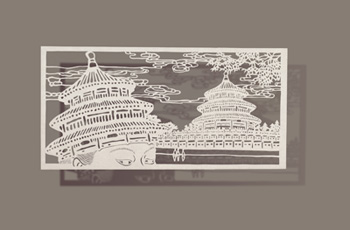NEWS & EVENTS > INTERVIEW
"A nation's culture resides in the hearts and in the soul of its people"
-Mahatma Ghandi
Bovey Lee- Cut Paper Artist
May 2015
May 2015

I think it's our attachment to paper. Paper is a material that everyone understands and uses. Perhaps many people have experience making papercutting works when they were children. It's part of everyone's childhood memories and that intimacy can be very powerful and longlasting.
What is your usual process of creating one of your pieces? How long does it take?
My work process is systematic and has three phases. Forming the idea is the first step; I spend a lot of time reading the news, observing people and things, researching from books, magazines, and the Internet. During this initial phase, I keep all the options open.
And then, I go through the process of filtering, refinement, and polishing the idea. This involves putting the idea on paper and/or on the computer.
Often times, I start "sketching" directly in PhotoShop, putting together a digital collage for each hand cut paper work from various sources. These collages are not high resolution or precise; they are merely image references and positioning guides for the final hand cut piece. Once I complete the digital template, I print it out and place it on top of the rice paper to cut with. The images are photographic and I translate them into patterns of solid and void, while cutting free hand without any rulers or stencils.
The laborious cutting occurs last because it is an irreversible phase. I have to be very certain of what I cut out and leave in. I hand cut each work on a single sheet of Chinese xuan (rice) paper backed with silk and both are renewable and eco-friendly materials. The tools I use are simple: cutting mat, X-acto knife and blades, staples, clips, and paperweights.
My work is like drawing with a knife and is rooted in my study of Chinese calligraphy and pencil drawing. Cutting paper is a visceral reaction and natural response to my affection for immediacy, detail, and subtlety. The physical and mental demand from cutting is extreme and thrilling, slows me down and allows me to think clearly and decisively. How long it takes depends on each piece, depending on its size and level of intricacy.
To what degree does the idea that papercutting is a Chinese cultural tradition and heritage, play into the conceptualization and realization of your work?
BL: It is a starting point for my work. I want to extend cut paper into the realm of the contemporary art world through referencing traditional folklore, iconographies, and cultural symbols. The cultural tradition and heritage becomes part of the commentary in my work that deals with contemporary issues of massive urbanization and its effects on the environment.
About Bovey Lee:
Bovey Lee is a cut paper artist based in Los Angeles, California, USA. Born in Hong Kong, Bovey has practiced Chinese calligraphy since the age of ten, and completed her BA degree in Fine Arts at the Chinese University of Hong Kong, and her Master of Fine Arts degree from the University of California at Berkeley. She earned a second MFA in computer graphics and interactive media at Pratt institute in New York, and in 2000 relocated to Pittsburgh where she created her first cut paper work in summer 2005.
Exhibitions include Nevada Museum of Art; Mesa Contemporary Arts Museum, Arizona; Wing Luke Museum, Seattle, Washington; Brooklyn Museum of Art; Shelburne Museum, Vermont; Museum Bellerive, Zurich, Switzerland; National Glass Centre, Sunderland, UK; Blackburn Museum, UK; Museum of Fine Arts, Beijing, China; Fukuoka Museum of Art, Japan; Hong Kong Museum of Art; Museum Rijswijk, The Netherlands; among others.
You can check out more of her work on her website, www.boveylee.com
Exhibitions include Nevada Museum of Art; Mesa Contemporary Arts Museum, Arizona; Wing Luke Museum, Seattle, Washington; Brooklyn Museum of Art; Shelburne Museum, Vermont; Museum Bellerive, Zurich, Switzerland; National Glass Centre, Sunderland, UK; Blackburn Museum, UK; Museum of Fine Arts, Beijing, China; Fukuoka Museum of Art, Japan; Hong Kong Museum of Art; Museum Rijswijk, The Netherlands; among others.
You can check out more of her work on her website, www.boveylee.com

